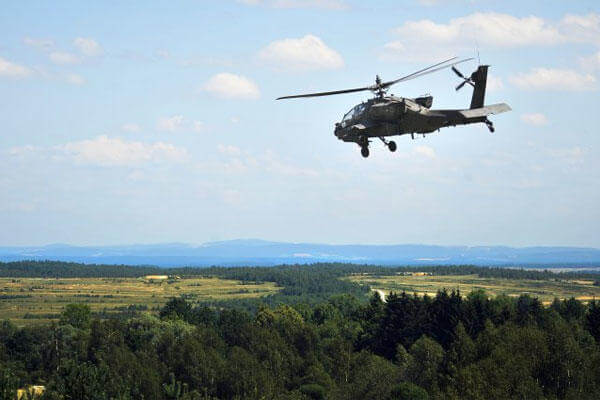WASHINGTON -- U.S. Army Europe is planning to request additional aviation support, through regionally aligned forces, to make up for shortfalls in aviation capability created by recent cuts made there as part of the Army's Aviation Restructure Initiative.
"What we are working to do, and what USAREUR is generating right now, which hasn't hit the street yet, is a request for forces ... to ask for more capability," said Col. Chris Waters, commander of 12th Combat Aviation Brigade. "We're going to ask for an additional attack battalion, a full assault battalion, portions of a general support aviation battalion, and an aviation support battalion."
Waters said one of the biggest deficits the 12th CAB now has is an ability to sustain itself for maintenance, movement, logistics support, and communications.
"That's what is organic to an aviation support battalion and that's what we lost when we deactivated that battalion," he said. "As we ask for an increase in forces, we have to ask for the complementary to sustain ourselves."
Already, two rotations of forces from the United States have been to Europe to support USAREUR. The first rotational force recently departed Germany and returned home to Savannah, Georgia. The second rotation, the 1st Air Cavalry Brigade, 357th Assault Helicopter Battalion, just arrived in Europe and will stay for nine months. The request USAREUR is developing now will be to bolster the next rotation that comes in, after the Soldiers from Fort Hood return to Texas.
"USAREUR has kind of validated it in our minds -- we need a whole lot more than that, and so we are going to ask for it," Waters said.
The 12th CAB lost half its AH-64 Apache fleet as part of the cuts, as well as a number of UH-60 Black Hawk aircraft, CH-47 Chinooks and some fixed-wing aircraft. The brigade also lost a number of medical evacuation helicopters, dropping from 30 to just six.
"As a result of the Army's restructuring ... we have less capability than we had before," Waters said. "And in my assessment, it has created an aviation deficit in EUCOM for rotor-wing capability. And we are going about trying to figure out how to solve that deficit. The resulting effects of that -- as we use what we have organically, plus our regionally aligned elements -- is that we are having a challenging time building readiness."
The 12th CAB initially had seven battalions. Of those seven, an assault helicopter battalion, a general support battalion, and a sustainment support battalion were all deactivated. An airfield operations battalion went to Fort Bragg, and an attack reconnaissance battalion went to Alaska.
The 12th CAB was able to keep a general support and fixed-wing battalion, as well as one attack reconnaissance battalion. The 12th CAB is also augmented by a rotational aviation force.
Strong Europe
Waters said a primary responsibility of 12th CAB is to participate in exercises to enable NATO partner nations. The brigade uses its aviation assets to do that.
He said that stateside, for instance, an infantry company training to do air assault would first be taught to board a helicopter. Then they would train on flying around and landing again, then in more complex environments, and then at night.
"Eventually you get where you can take an assault company or assault battalion and you can move an infantry company or an infantry battalion," he said. "We do the exact same thing with NATO partners."
Waters said that even if those partners don't have organic rotary wing capability, the U.S. might support them in the future, so they are trained to operate with U.S. helicopters.
"That is a big charter, to enable our allies to operate," he said.
In fiscal year 2015, U.S. Army Europe participated in 51 exercises in Europe, with most requiring rotary-wing helicopter. In fiscal year 2016, he said, USAREUR is expected to participate in 62 USAREUR, U.S. European Command, or NATO exercises.
"Those exercises are the structures by which we ... work toward interoperability," with partner nations, Waters said. Such exercises help allied nations work toward common tactics, techniques, and procedures, communications capabilities, encryption standards and techniques to deal with electronic warfare challenges.



























